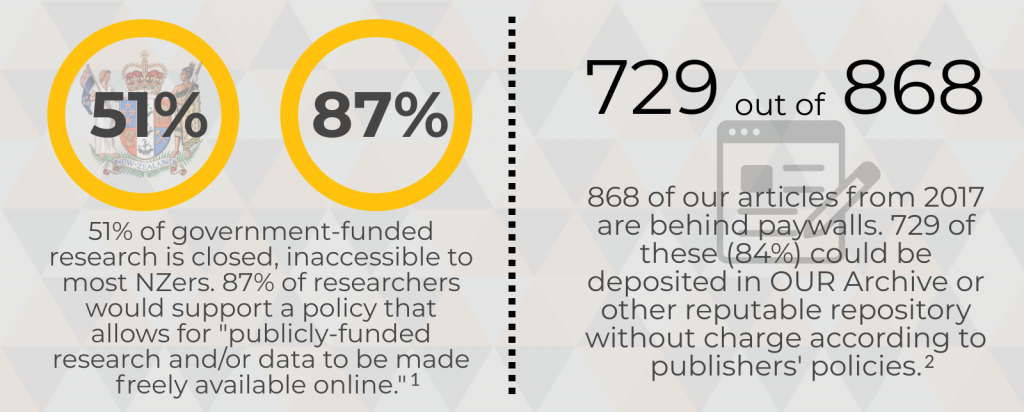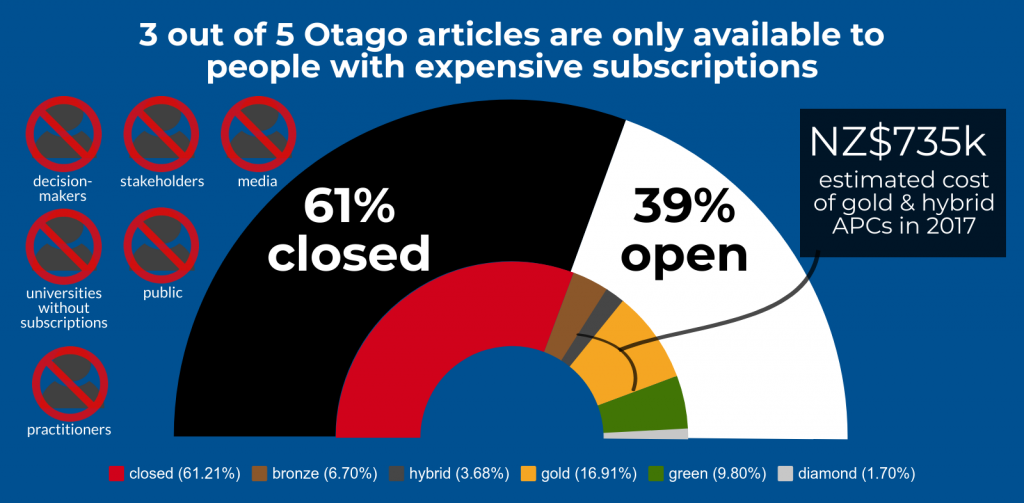When I talk to researchers about open access, cost is often the first thing that comes up. We know that researchers are in principle overwhelmingly in favour of their work being free to read (with 87% in a large survey backing open as default)¹ but, as we saw yesterday our practice in making our work open is hugely at odds with this since 39% of Otago-authored articles are openly accessible. Cost is definitely one barrier but lack of understanding of the scholarly publishing ecosystem is just as much a factor. Today’s post looks at these issues – it’s going to get detailed further down, so buckle up.
The short version is: we pay a lot for subscription access still and a not-insignificant amount on top of that for open access publications but we could be doing a lot more to make our work open in other, cheaper ways that are just as good (if not better).
The longer version? Here we go.
Most readers will know that publishers charge us subscription fees for access to research. This is still how we get access to most electronic material we use in teaching and research. In 2017 New Zealand universities combined spent $68.5 million on access to electronic resources and this goes up each year.² Open access came along but in some of its models this actually introduced a new cost, where publishers charge the authors/researchers to make it open as opposed to libraries (with fees known as Article Processing Charges or APCs). As I said yesterday that’s where our work estimated $735,000 spent by Otago researchers in 2017.³ The figure for the eight universities combined was $2.1 million so Otago’s share was about one-third.
This estimated $735k was spent for two types of open access, as indicated by the black line with the curved line at the end of it. The vast majority of this money was for what are termed Gold OA journals, where there is no subscription fee and all articles are open access with an APC charged to the authors (about $642k or 87% of the total), like Public Library of Science or Biomed Central. The remainder was in Hybrid journals, which charge libraries subscriptions but allow researchers the option of paying an APC to open up that particular article to all readers (e.g. the Lancet, Nature). This is an area of interest for further investigation: why did our researchers choose to publish in these venues and pay this fee, especially where it was optional in the Hybrid cases?
But there are other ways to make your work open. There are several different ‘shades’, as indicated in the smaller arch in the graphic,⁴ but the Green OA proportion is of particular interest because there are no APCs. My title for this post was deliberately provocative and not strictly true: it’s doesn’t cost ‘nothing’ to self-archive in that it requires time and effort to do it and repositories must be developed and maintained. But it’s much cheaper at scale than paying publishers $3000 to $4000 on average per article, with one piece of work identifying the cost per-article of depositing in a repository to be NZ$62.⁵
Most publisher policies now allow you to deposit an accepted manuscript in a non-commercial repository, sometimes with the proviso that you have to wait for a period after publication, most commonly 12 months. (Note: you can actually check the policy of any journal here). The figure on the right here shows what we could have deposited perfectly legally in a repository but haven’t:
People don’t realise they can do this or they don’t feel it’s worth the time and effort to do so. But they likely also don’t understand that on average there appears to be a big advantage in self-archiving your work in terms of impact, which is the subject of tomorrow’s post for OA Week 2019.
Richard White is the Manager, Copyright and Open Access at the University of Otago.
This is one of a series of posts for Open Access week 2019. The comments can be used below for discussion or debate. Otago staff can refer to our Open Access Policy and associated Guidelines.
Notes
For the national results of the research referred to here, including an infographic and full report, refer to the Universities New Zealand website for:
- Infographic: CONZUL OA Project Group (June 2019). NZ open access: what do we know?
- Full report: CONZUL OA Project Group (August 2019). Open Access in New Zealand universities: an environmental scan.
¹ Blankstein, M., & Wolff-Eisenberg, C. (2019, April 12). Ithaka S+R US Faculty Survey 2018. doi: 10.18665/sr.311199
² The Consortium of New Zealand University Libraries reported that subscription to electronic content in 2017 cost universities NZ$68.5 million. See the Universities NZ submission to the Copyright Act review p. 28. For context the Marsden Fund gave out $84.6 million (Source: Royal Society).
³ This estimate is an estimate because, while we know how many 2017 articles were published where the corresponding author was an Otago researcher in a journal that would require an APC to be paid, we don’t know for sure if that fee was waived or paid by someone else.
⁴ Getting into the minute detail, we can break down the white 39% open section in the graph above into sub-groups to show how the articles were made open. The largest proportion was for Gold OA (16.91% of all articles); next comes Green OA at just under 10% (sometimes called self-archiving, where articles are published in a closed journal but an accepted manuscript version is deposited in a repository like OUR Archive); Bronze OA (6.7%) is where the article is currently freely available but it’s status is uncertain and could change; Hybrid (optional APC) and Diamond (free to publish, free to read) made up the remainder.
⁵ Johnson, R., Pinfield, S., & Fosci, M. (2016). Business process costs of implementing “gold” and “green” open access in institutional and national contexts. Journal of the Association for Information Science and Technology, 67(9), 2283-2295. doi.org/10.1002/asi.23545


